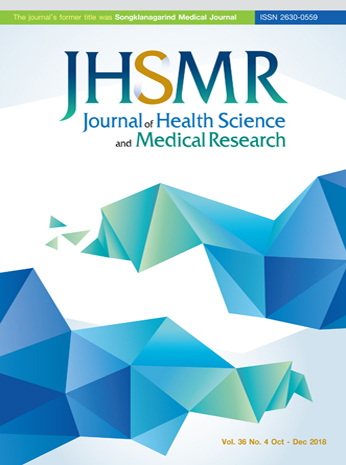Pain, Stress and Anxiety of Chronic Pain Patients Prior to, During and After Political Turmoil in Thailand
DOI:
https://doi.org/10.31584/jhsmr.201827Keywords:
anxiety, military dictatorship, pain, politics, political crisis, political turmoil, stressAbstract
Objective: Thailand was plagued with serious political turmoil for many years. We would like to know whether this turmoil has had an impact on our chronic pain patients in terms of intensity of pain, stress and anxiety, as well as daily living and sleep.
Material and Methods: Patients with at least 3 months of pain prior to 31 October 2013 (the date that the demonstrations started) were enrolled in this study. The data were collected from the patients who attended our pain clinic from December 2014 to May 2015. The patients were asked to complete a questionnaire on their severity of pain, stress and anxiety for the 3 different stages: prior to the demonstrations (period 1), during the demonstrations (period 2) and under military dictatorship or after the demonstrations (period 3).
Results: There were 120 patients, 49 males (40.8%) and 71 females (59.2%). The mean age was 56.3±15.8 years old (range 18-88). The majority were Buddhist (108 patients, 90.0%) while 11 patients (9.2%) were Muslim and 1 patient (0.8%) was Christian. The mean duration of pain prior to the beginning of the demonstrations was 62.8 months (range 3-324 months). Regarding the pain score, the mean maximum pain score was significantly different between periods 1 (8), 2 (7.7) and 3 (6.8) (p-value<0.001). Regarding the anxiety score, the mean maximum anxiety score was significantly different between periods 1 (3.8), 2 (4.8) and 3 (2.9) (p-value=0.03). Regarding the stress score, the mean maximum stress score was significantly different between periods 1 (3.8), 2 (4.4) and 3 (2.8) (p-value=0.02). Using multiple logistic regression analysis, no factors (gender, age, religious, duration of pain and levels of anxiety and stress) were found to have contributed to the reduction of pain intensity.
Conclusion: The demonstrations during the political turmoil did not increase the severity of pain but led to higher levels of stress and anxiety. On the other hand, under the military dictatorship, lower pain scores as well as stress and anxiety levels in chronic pain patients attending our pain clinic have been found.
References
2. Treede RD, Rief W, Barke A, Aziz Q, Bennett MI, Benoliel R, et al. A classification of chronic pain for ICD-11. Pain 2015;156:1003-7.
3. Dansie EJ, Turk DC. Assessment of patients with chronic pain. Br J Anaesth 2013;111:19-25.
4. Johnson MH. How does distraction work in the management of pain? Curr Pain Headache Rep 2005;9:90-5.
5. DiMatteo MR, Giordani PJ, Lepper HS, Croghan TW. Patient adherence and medical treatment outcomes; a meta-analysis. Med Care 2002;40:794-811.
6. Garaffa G, Trost LW, Serefoglu EC, Ralph D, Hellstrom WJ. Understanding the course of Peyronie’s disease. Int J Clin Pract 2013;67:781-8.
7. American Psychological Association. Anxiety [homepage on the Internet]. Washington: APA; 2016 [cited 2016 Jul 17]. Available from: https://www.apa.org>topics>anxiety
8. World Health Organization. The world health report 2001 - Mental health: new understanding, new hope. Geneva: W. Press;2001.
9. Kohrt BA, Hruschka DJ, Worthman CM, Kunz RD, Baldwin JL, Upadhaya N, et al. Political violence and mental health in Nepal: prospective study. Br J Psychiatry 2012;201:268-75.
10. World Health Organization. World report on violence and health. Geneva: WHO; 2002.
11. Cotchett M, Munteanu SE, Landorf KB. Depression, anxiety, and stress in people with and without plantar heel pain.
Foot Ankle Int 2016;37:816-21.
























